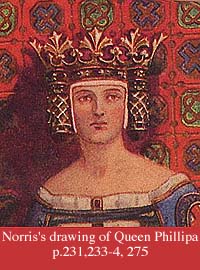

I've wanted a set of crespinettes for a long time. So, by
gum, I was going to make a set. Or a coronet with crespinettes.
Or a fillet with cylinder cauls. Or whatever you'd like to call them.
But first, I needed pictures to work from.
Now, Herbert Norris's book Medieval Costume and Fashion is not as precise with sources, attributions, and rendering as one might wish, but in terms of general knowledge, it's not bad. When Dover republished it with all the drawings in 1999, I snapped up a copy. I think it is a good book for getting a sense of development of styles over time -- fairly good to hand to a new person as they're trying to figure out what they want for clothing.
So it was to Norris that I went, to bracket my time ranges. The first picture is my favorite style, in Norris.
Now that I had a name, and a date (he lists her as 1350), I could try and track down a real medieval picture, statue, etc, of the Queen, and see if there were more information to be gained from it, and as a "triangulation" on Norris's interpretation. Here is the only medieval image of the Queen that I've been able to find so far.
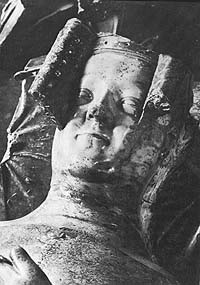
You might notice that if Norris took his drawing of the Queen from this effigy, she's either been vandalized since he saw her, or he's made many leaps of faith. The effigy does not have projecting leaves on her crown, or else they rest aginst the pillow, where we can't see them in this picture. The cylinders rest right at the edges of her eyes. It doesn't look as if there is an under-cap lining her face. The bottom of the cylinders are missing. The dress does have a low horizontal neckline, but it's not as deep, and the dress appears to be laced, rather than showing the top of a furred, jeweled, sidless surcoat. All of these could be arguments for the effigy *not* being Norris' source -- or evidence that he was very inventive. I don't know.
Continuing to search, I did find the following image from the Metropolitan Museum's website. It shows a similar style, but without the metal crespinettes; does show an under-cap, or, possibly, the ends of pigtails projecting forward. The vertical braids are just in front of, and somewhat over, her ears. The circlet only bumps out a little, to accomodate the braids. The date of this bust is listed as the 1340s, of Marie de France.
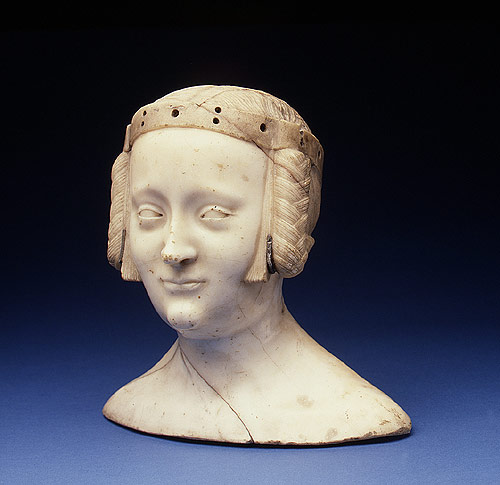
Searching a little more, the Museum of London's book on Dress Accessories shows a line drawing (from a brass memorial plaque, 1360) of a woman with vertical braids, circlet, and a thin veil showing at the back of her neck and projecting in front of the braids, just like Marie's. The Museum also has a ribbon circlet with false braids still attached to it, from 1325-1350.
Taking all these together, I decided that my need for provenance on this project had been satisfied, and I began work. NOTE: the version pictured here was later amended with more complex netting, pearls, and brown silk underlayment instead of brown wool. A whole-body picture of me in the new version.
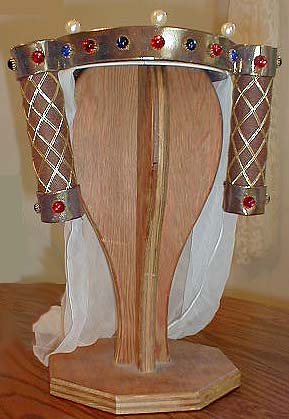 I'm no jeweler nor metalsmith, and yet the case was fairly solid that many
of these were of metal, the ribbon version notwithstanding. So here,
another leap of faith was needed: I'd try to replicate a metal crown using
fabric. This is not such a difficult thing to do, thanks to the Space
Age -- mylar is readily available, and the particular version available
to me at the local JoAnne's Fabrics is called "liquid gold." It's
a polyester knit fabric, very smooth and dense, on which has been printed
mylar ovals. At a distance of about 6 feet, it looks like metal.
It was all I had to go on, so heck, why not, I thought.
I'm no jeweler nor metalsmith, and yet the case was fairly solid that many
of these were of metal, the ribbon version notwithstanding. So here,
another leap of faith was needed: I'd try to replicate a metal crown using
fabric. This is not such a difficult thing to do, thanks to the Space
Age -- mylar is readily available, and the particular version available
to me at the local JoAnne's Fabrics is called "liquid gold." It's
a polyester knit fabric, very smooth and dense, on which has been printed
mylar ovals. At a distance of about 6 feet, it looks like metal.
It was all I had to go on, so heck, why not, I thought.
Out of very stiff woven interfacing from Greenberg & Hammer (professional sewing suppliers in NYC; wonderful selection) I made the coronet, and the four small loops that were to go at the top and bottom of the cylinders. These fit over paper-towel tubes, cut to size, which had been covered with brown fabric and a net of gold soutache braid. (Paper-towel tubes are just the right diameter for the cylinders. The Simplicity pattern's set are much too wide.) I may eventually embelish these further. It was important that the fabric be as smooth as possible on the outside, so that no betraying seam nor stitch give the idea that it might not be metal.
For the inside of the circlet, and to hide the stitching, I made a "hatband" of black fabric surrounding a double run of lightweight boning. This further supported the circlet so it wouldn't sag and betray its textile origins. Beading pins support the pearls which proclaim me a baroness in the SCA. The red, blue, and lapis glass cabochens are sewn on, but the settings are metal, so they look properly soldered to the "metal" of the circlet.
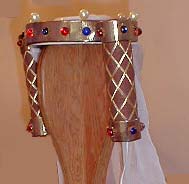 I
pinned a sheer silk veil to the inside front edge of the hatband.
For the moment, I opted to have it not show underneath the cylinders; it
just goes over the top of my head, and under the back span of the circlet.
It's currently too long; it shouldn't go much below my shoulder blades,
I think. The thin line of white at the forehead in these two pictures
is a bowl that I used to help position the coronet on the hatform.
I
pinned a sheer silk veil to the inside front edge of the hatband.
For the moment, I opted to have it not show underneath the cylinders; it
just goes over the top of my head, and under the back span of the circlet.
It's currently too long; it shouldn't go much below my shoulder blades,
I think. The thin line of white at the forehead in these two pictures
is a bowl that I used to help position the coronet on the hatform.
Like most other headgear from this time period, and for the next 100
years, one's hearing is muffled, wearing it. I don't know if possibly
this was a sign of conspicuous consumption or intentional impracticality,
like modern long fingernails that show one is not a laborer, or whether
it was meant to keep one warm in drafts!
| © 2000 Cynthia Virtue | Email Author with comments |
| Back to Virtue Ventures Main Page | Back to Article Index |